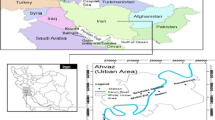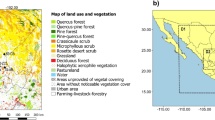Abstract
One of the most important environmental problems in recent years in the Middle East including Iran is the dust storm events. The main goal of this research was to conduct statistical analyses to identify the dusty days with visibility to less than 1 km. This study also dealt with the recognition of sources of this phenomenon and the route for dusts to enter Isfahan Province. In this study, data were collected for a 20-year period (1994–2013) including daily dust data at the ground stations, brightness temperature at wavelengths of 11 μm and 12 μm, and GDAS data for tracking the dust particle route in HYSPLIT software. Naein and Airport stations with frequencies of 920 and 919 days of dust (respectively) were identified as two critical centers of dust in Isfahan province. The spring season had the highest number of days with dust. Also, the highest and lowest frequencies of this event were observed in April–May–June and December–January, respectively. The border area between Iraq and Syria, west and southwest of Iraq, was the main source of the dust transported to Isfahan. Thermodynamic conditions of atmosphere using the Skew-T diagrams were stable during the dust events in the study area.











Similar content being viewed by others
Data availability
Upon a reasonable request to the corresponding author of this study, the data generated and/or analyzed during this study can be available.
Notes
Rawin Sonde Observation Program
References
Ackerman SA (1997) Remote sensing aerosols using satellite infrared observations. J Geophys Res 102:17069–17079
Akbary M, Farahbakhshi M (2015) Analyzing and tracing of dust hazard in recent years in Kermanshah Province. Int J Environ Res 9(2):673–682
Al-Jumaily KJ, Ibrahim MK (2013) Analysis of synoptic situation for dust storms in Iraq. Int J Energy Environ 4(5):851–858 broblasts: Toxiology in vitro; 21; 632-638
Ashrafi K, Shafipour motlagh M, Aslmand A (2013) Pathways dust storm on the use of numerical modeling and satellite images. J Environ 56:3–12
Atayi H, Ahmadi F (2011) Dust as one of the environmental problems of the Islamic world, case study: Khuzestan. Fourth International Congress of the Islamic World Gographers. 1–19
Azizi GH, Shamsipour AA, Miri M, Safarrad T (2012) Synoptic and remote sensing analysis of dust events in southwestern Iran. Nat Hazared 64:1625–1638
Boddock MC, Bullard JE, Bryant RG (2009) Dust source identification using MODIS: a comparison of techniques applied to the Lake Eyre Basin Australia. Remote Sens Environ 113:1511–1528
Boochani MH, Fazeli D (2011) Environment challenges and its consequences case study: dust and its impact in the West of Iran. Qua Doc Pol Mak 2(3):125–146
Boroghani M, Pourhashemi S, Zangane Asadi M, Moradi HA (2017) Dust source identification in the Middle East by using remote sensing. J Nat Environ Hazards 6(11):101–118
Ciren P, Kondragunta S (2014) Dust aerosol index(DAI) algorithm for MODIS. J Geophys Res Atmos 119(8):2347–2368
Dehghanpour AR, Halabian AH, Fallahpour M (2014) Impact of wind derection and speed on dusty days. Int J Adv Biotechnol Res 2(5):1742–1749
Dubovik O, Lapyonok T, Kaufman YJ, Chin M, Ginoux P, Kahn RA et al (2008) Retrieving global sources from satellites using inverse modeling. Atmos Chem Phys 8(2):209–250
Goudie A, Middleton NJ (2006) Desert Dust in the Global System. Springer: Heidelberg, Germany
Huang M, Peng G, Zhang J, Zhang S (2006) Application of artificial neural networks to the prediction of dust storms in North west China. Glob Planet Chang 52:216–224
Kang L, Huang J, Chen S, Wang X (2015) Long-term trends of dust events over Tibetan Plateau during 1961-2010. Atmos Environ 125(2016):188–198
Karegar E, Bodagh Jamali J, Ranjbar Sadat Abadi A, Moeenoddini M, Goshtasb H (2017) Simulation and numerical analysis of sever dust storms Iran East. Jsaeh. 3(4):101–119
Kim H-S, Chung Y-S, Yoon M-B (2016) An analysis on the impact of large-scale transports of dust pollution on air quality in East Asia as observed in Central Korea in 2014. Air Qual Atmos Health 9:83–93
Kluster L, Schepanski K (2009) Remote sensing of mineral dust over land with MSG infrared channels: a new Bitemporal Mineral Dust Index. Remote Sens Environ 113:1853–1867
Lashgari H, Keykhosravi G (2008) Synoptic statistical analysis of dust storms in Khorasan Razavi province during the time interval (1993-2003). Phys Geog Res Quarterly 65:17–33
Lin G (2002) Dust bowl in the 1930 and sand storm in 1999 in the USA, Global Alarm: Dust and sand storms from the word drylands, United Nations. P52
McTainsh GH, Pitblado JR (1987) Dust storms and related phenomena measured from meteorological records in Australia. Earth Surf Process Landf 12(4):415–424
Mei D, Xiushan L, Lin S, Ping W (2008) A dust-storm process dynamic monitoring with multi-temporal MODIS data. Int Arch Photogramm Remote Sens Spat Inf Sci XXVII(Part B7):965–970
Miller SD (2003) A consolidated technique for enhancing desert dust storms with MODIS. Geophys Res Lett 30(20):2071–2074
Mohammadi Moradian J, Hosseinzadeh SR (2015) The study of desert dust in Mashhad Metropolis using satellite images and synoptic dataset (2009-2013). J Geogr Environ Hazards 4(14):35–57
Pahlavanravi A, Miri A, Ahmadi A, Ekhtesasi MR (2012) The impacts of different of dust storms in hot and dry climate, a case study in Sistan region. Desert 17:15–25
Prospero JM, Ginoux P, TorresOS, Nicholson E, Gill TE (2002) Environmental characterization of global sources of atmospheric soil dust identified with the Nimbus 7 Total Ozone Mapping Spectrometer (TOMS) absorbing aerosol product. Rev Geophys 40, 1(art. No.1002)
Qu JJ, Kafatos M (2006) Asian dust storm monitoring combining Terra and Aqua MODIS SRB measurments. Geosci Remote Sens Lett 3(4):484–486
Rezazadeh M, Irannejad P, Shao Y (2013) Climatology of the Middle East events. Aeolian Res 10:103–109
Taghavi F, Owald E, Safarrad T, Irannejad P (2013) Identifying and monitoring dust storm in the western part of Iran using remote sensing techniques. Earth Space Phys J 39(3):83–96
Tan M, Li X, Xin L (2014) Intensity of dust storms in China from 1980 to 2007: a new definition. Atmos Environ 85(4):215–222
Xie Y, Zhang W, Qu JJ (2017) Detection of Asian dust storm using MODIS measurements. Remote Sens 9(869):2–17
Zeinali B (2016) Investigation of frequency changes trend of days with dust storms in western half of. Iran. 5(7):87–100
Zheng X, Lu F, Fang X, Wang Y, Guo L (1998) Study of dust storms in china using satellite data, SPIE Proc. On Optical Remote Sensing of the Atmosphere and Cloud, Edited by J. Wang, B., Wu, T., Ogawa, and Z., Guan, Proc. Vol. 3501, 163-168
Author information
Authors and Affiliations
Corresponding authors
Additional information
Publisher’s note
Springer Nature remains neutral with regard to jurisdictional claims in published maps and institutional affiliations.
Supplementary Information
ESM 1
(DOCX 19.8 kb)
Rights and permissions
About this article
Cite this article
Jafari, M., Mesbahzadeh, T., Masoudi, R. et al. Dust storm surveying and detection using remote sensing data, wind tracing, and atmospheric thermodynamic conditions (case study: Isfahan Province, Iran). Air Qual Atmos Health 14, 1301–1311 (2021). https://doi.org/10.1007/s11869-021-01021-x
Received:
Accepted:
Published:
Issue Date:
DOI: https://doi.org/10.1007/s11869-021-01021-x




